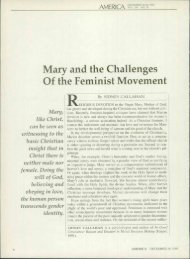Create successful ePaper yourself
Turn your PDF publications into a flip-book with our unique Google optimized e-Paper software.
SIGNS OF THE TIMES<br />
is 36, consistent with the average over<br />
the past five years. The average age at<br />
ordination in the 1950s and 60s by<br />
contrast was 26, but that gradually<br />
climbed in the next three decades. It<br />
now has apparently leveled out. Age at<br />
ordination is significant for projecting<br />
the future pool of active priests,<br />
because a man ordained at 26 might be<br />
expected to have as many as 50 years of<br />
active service, while one ordained at 36<br />
would more likely have at most 40<br />
years ahead of him before retiring or<br />
removal from service by illness, death<br />
or other causes.<br />
A senior research associate at<br />
CARA, Mary L. Gautier, said that<br />
another recently completed but not yet<br />
published CARA study found that<br />
only 64 percent of the nation’s 27,614<br />
diocesan priests are fully active. She<br />
said that study’s findings are consistent<br />
with figures from the 2008 Official<br />
Catholic Directory, which listed 8,433<br />
of the country’s diocesan priests, or 31<br />
percent, as retired, ill or absent on<br />
leave. Just 10 years earlier, the directory<br />
reported that there were some 4,000<br />
more diocesan priests, but at that time<br />
only 24.6 percent of them were listed<br />
as inactive because of retirement, illness<br />
or leave of absence. Thus the<br />
number of active diocesan priests has<br />
dropped from nearly 24,000 in 1997<br />
to a little over 19,000 in 2007.<br />
JERRY FILTEAU, a freelance journalist, retired<br />
in 2007 after 35 years with Catholic News<br />
Service.<br />
NEWS<br />
BRIEFS<br />
Pope Benedict XVI and the secretary-general of the<br />
League of Arab States signed an agreement on April<br />
23 at the Vatican, pledging to cooperate more closely in<br />
the promotion of dialogue, justice and peace. •<br />
Northern Ireland’s Catholic bishops have met with<br />
representatives of a loyalist group in an effort to build<br />
“peace, understanding and reconciliation,” Cardinal<br />
Seán Brady of Armagh, Ireland, said on April 25. •<br />
The Israeli Civil Administration has ordered workers<br />
to stop constructing a platform inside the Aida Seán Brady<br />
refugee camp in the West Bank for use during Pope<br />
Benedict XVI’s visit to the camp. An Israeli spokesman said the construction<br />
is in an area under Israeli jurisdiction and is being carried out<br />
without a permit. • Citing concerns about plans to honor President<br />
Barack Obama, former U.S. Ambassador to the Vatican Mary Ann<br />
Glendon has turned down the prestigious Laetare Medal from the<br />
University of Notre Dame, which was to be awarded to her on May 17.<br />
Bishops Urge New<br />
President to Fight AIDS<br />
The leader of the Southern African<br />
Catholic Bishops’ Conference has<br />
urged Jacob Zuma to intensify the<br />
fight against AIDS when he takes<br />
office in May as that country’s next<br />
president. AIDS and H.I.V. need to<br />
be “our national priority, for it is dealing<br />
death to so many South African<br />
families and communities,” said<br />
Archbishop Buti Tlhagale of<br />
Johannesburg in a letter to Zuma<br />
published in South Africa’s Sunday<br />
Times on April 26. Calling H.I.V. and<br />
AIDS “the greatest threat to our<br />
country’s health and security,”<br />
Archbishop Tlhagale said the nongovernmental<br />
sector “can and must be<br />
given a supportive role in attacking<br />
this threat, but it is important that the<br />
government takes the initiative and<br />
leads the broader society in this new<br />
struggle.” The archbishop said nongovernmental<br />
organizations “are<br />
weary of fighting the government for<br />
what it is constitutionally, legally and<br />
morally bound to deliver.”<br />
Activists Lobby U.N.<br />
on Sri Lanka<br />
Leading human rights advocates, led<br />
by the Global Centre for the<br />
Responsibility to Protect, have written<br />
an open letter calling on the U.N.<br />
Security Council to take immediate<br />
action to prevent atrocities in Sri<br />
Lanka. A rebel force fighting the Sri<br />
Lankan government, the Liberation<br />
Tigers of Tamil Eelam, is refusing to<br />
let noncombatants leave the combat<br />
zone and is using the noncombatants<br />
as human shields. The Sri Lankan<br />
army has begun a final assault on the<br />
rebels that could lead to the deaths of<br />
thousands of civilians.<br />
John Holmes, the U.N. Emergency<br />
Relief Coordinator, has said that “a<br />
bloodbath...seems an increasingly real<br />
possibility.” Navi Pillay, the U.N.<br />
High Commissioner for Human<br />
Rights, has stated that casualties may<br />
reach “catastrophic levels” if the fighting<br />
is not stopped. “At the core [of the<br />
responsibility to protect] is the obligation<br />
to act preventively to protect peoples<br />
from genocide, war crimes, crimes<br />
against humanity and ethnic cleansing,<br />
rather than waiting until atrocities<br />
have already occurred, as states<br />
have too often done in the past,” said<br />
the letter’s signatories.<br />
8 <strong>America</strong> May 11, 2009









